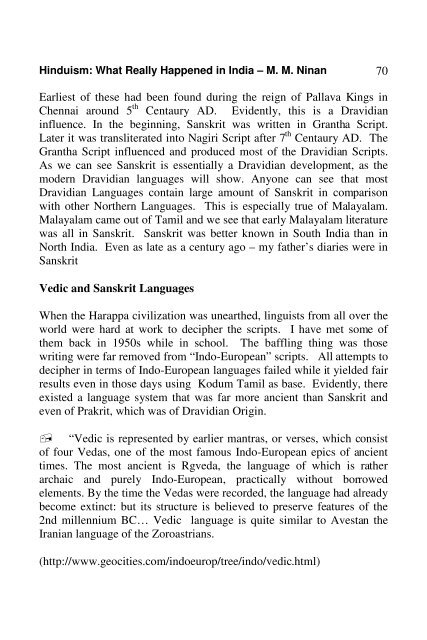Create successful ePaper yourself
Turn your PDF publications into a flip-book with our unique Google optimized e-Paper software.
<strong>Hinduism</strong>: What Really Happened in India – M. M. Ninan 70<br />
Earliest of these had been found during the reign of Pallava Kings in<br />
Chennai around 5 th Centaury AD. Evidently, this is a Dravidian<br />
influence. In the beginning, Sanskrit was written in Grantha Script.<br />
Later it was transliterated into Nagiri Script after 7 th Centaury AD. The<br />
Grantha Script influenced and produced most of the Dravidian Scripts.<br />
As we can see Sanskrit is essentially a Dravidian development, as the<br />
modern Dravidian languages will show. Anyone can see that most<br />
Dravidian Languages contain large amount of Sanskrit in comparison<br />
with other Northern Languages. This is especially true of Malayalam.<br />
Malayalam came out of Tamil and we see that early Malayalam literature<br />
was all in Sanskrit. Sanskrit was better known in South India than in<br />
North India. Even as late as a century ago – my father’s diaries were in<br />
Sanskrit<br />
Vedic and Sanskrit Languages<br />
When the Harappa civilization was unearthed, linguists from all over the<br />
world were hard at work to decipher the scripts. I have met some of<br />
them back in 1950s while in school. The baffling thing was those<br />
writing were far removed from “Indo-European” scripts. All attempts to<br />
decipher in terms of Indo-European languages failed while it yielded fair<br />
results even in those days using Kodum Tamil as base. Evidently, there<br />
existed a language system that was far more ancient than Sanskrit and<br />
even of Prakrit, which was of Dravidian Origin.<br />
“Vedic is represented by earlier mantras, or verses, which consist<br />
of four Vedas, one of the most famous Indo-European epics of ancient<br />
times. The most ancient is Rgveda, the language of which is rather<br />
archaic and purely Indo-European, practically without borrowed<br />
elements. By the time the Vedas were recorded, the language had already<br />
become extinct: but its structure is believed to preserve features of the<br />
2nd millennium BC… Vedic language is quite similar to Avestan the<br />
Iranian language of the Zoroastrians.<br />
(http://www.geocities.com/indoeurop/tree/indo/vedic.html)


















